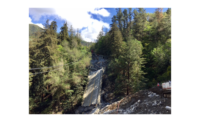Caltrans engineers are scrambling to replace Pfeiffer Canyon Bridge, a 317-ft-long, concrete continuous box-beam bridge on a key coastal highway after mudslides moved one of the support columns more than a foot, causing the span to crack and bow.
Caltrans closed Highway 1 in Big Sur on Feb. 15 and determined that it would have to be replaced after a wet winter undermined the foundation on the steep hillside. The closure left some residents stranded, as other routes were blocked by mudslides in the area.
But crews now are stymied by the damaged structure. “We expected the demolition to take a day or two, but the demolition ball wasn’t striking the deck with the velocity we had hoped,” says
Caltrans spokesman Jim Shivers. Crews used a crane to drop the wrecking ball from a height of up to 10 ft. Shivers hopes to resume demolition after a day’s delay to bring in more equipment. “We are trying to do this in a controlled way, but it is still an unpredictable environment and an active slide area,” he observes.
The damage was first noticed on Feb. 11. Maintenance crews discovered that one of the bent columns was not plumb and cracks were apparent. Four days later, Caltrans engineers measured a 5° tilt in the column. Another intense rainstorm on Feb. 19 caused the slope under the foundation to slide significantly and put more pressure on the column, resulting in major cracks and a 6-in. dip in the deck.
Caltrans bridge maintenance engineer Erol Kaslan praises the 1968 structure for performing better than anticipated. “It didn’t have all the seismic detailing we build in bridges today, but it failed in a very ductile manner, redistributing load so we could continue to allow limited access to evacuate residents,” he says.
Kaslan adds, “The reinforced-concrete box girder bridge is as tough as a Sherman tank.” The ductile design of the column allowed it to remain stable, resisting collapse. “The damage we saw was not unlike the effect from an earthquake,” he says.
Caltrans is still cleaning up a number of corridor slides and slip-outs on coastal roadways and inspecting infrastructure in the process. From its list of emergency contractors, the agency called on Golden State Bridge to do the cleanup. As it is still an active slide area, Caltrans has not yet been able to access the steep hillside to do core drilling and determine the exact cause.
To speed up design and construction for the replacement bridge, Caltrans turned to a 315-ft, two-lane, clear-span welded-steel-plate-girder design with a reinforced-concrete deck, similar to the $4.5-million Whites Hill Sidehill Viaduct bridge, built in Marin County in 2002. “The design was selected because the foundations would be outside of the slide area and the steel girders could be shipped in and built rapidly,” Kaslan says.
While many of California’s bridges use a design similar to the one that was damaged in the storm, Kaslan does not believe they carry the same vulnerability. Pfeiffer Canyon Bridge was built almost 50 years ago on a foundation anchored in bedrock. Movement under the surface changed the characteristics of the Franciscan Formation rock, leaving it vulnerable. “We are treating this as an anomaly,” Kaslan says.
The American Road & Transportation Builders Association estimates that as much as 10% of the 611,845 highway bridges in the country are “structurally deficient.” Of California’s structurally deficient bridges, six of the top 10 most traveled are on Highway 110 in Los Angeles.



